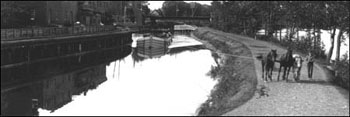
The canal’s towpath
Chambly Canal National Historic Site
The route commonly known as the canal’s path bears a history-filled name: the towpath. It enabled vessels to be towed (or drawn) over the canal’s 20 kilometres. The writings of Captain Frank H. Godfrey report that the Chambly Canal’s towpath was considered to be “the best in America.” The path has been very well preserved: only the section between Bridge No 9 and Bridge No 10 has been converted into a road.
History
In the era when barges accounted for a majority of commercial shipping on the canal, it was necessary to develop a path to provide for the towing of vessels. On the Chambly Canal, boats were towed by horses. The canal was even considered to be a “horse canal. ” Vessels did not always use the services provided by the towmen: this was true of steamships. Some barges also relied on steam tugboats in their journeys along the canal. These vessels caused serious damage to the locks, which slowed shipping.
With the arrival of new technologies in the early 20th century, towing by horses was on its way out. The towmen tried to maintain their monopoly and opposed these new techniques. The arrival of tractors and of the first diesel-powered barge in 1934 would put an end to the towmen’s work and to the commercial use of the towpath.
Quotation
“The best towpath to my knowledge was the Chambly, a Canadian Canal on the Richelieu River, eleven and one-half miles long from St. Jean to Chambly. The towpath was wide enough that nine horses could not have filled it. There was no place that a team could not climb out of the canal. Watering places for the teams, and from about 1902, the towpath was electric-lighted the entire length of the canal.” (Excerpt from The Godfrey Letters, Captain Frank H. Godfrey, 1973)
On a lighter note
“To swear like a towman.” The towmen had the habit of using crude language. Their arduous job, the accidents that could occur (horses might sometimes fall into the water), the harsh weather and the length of the journey to Saint-Jean (10 to 12 hours) would often try their patience. In 1878, the canal superintendent took legal action against the towmen. Punitive measures were instituted against abusive and vulgar language, which could result in a $40 fine.
Do you know what is a towman?
The towman’s trade consisted of leading horses from one end of the canal to the other to tow barges within the locks. The towing season extended from April to September and lasted 200 to 215 days. During this period, towmen could work as much as 20 hours a day. The towman plods wearily behind his horses. The towpath is lit up by the full moon, as the barge laden with coal glides along the water, 100 m behind him. The July night is hot and sultry.
The day has gone well: even if the horses seem a trifle edgy, there have been no accidents, broken harnesses, falls in the water, or collisions. Everything has gone smoothly but the towman is dead tired. He has been up since before daybreak, at work since 4 o'clock this morning and it is now nearly 10 at night.

© McCord Museum of Canadian History / Notman
In a few minutes, he will reach the locks and be nearly home. But he still has to take his barge through the locks, water and feed his horses and clean any sores from their rubbing bridles before bedding down for a few hours of well-earned rest.
In no time it will be tomorrow, with more barges at the quay waiting to be towed toward Saint-Jean. Since the siren sounded signalling the arrival of the first boats in mid-May, things have been busy and the weather gloomy. But however exhausting the work, there is no question of taking time off: the barges must be brought up at once, and the Chambly Canal towmen are the people who have to do it."
Adapted from a text by Bernadette Laflamme,
President, Chambly Seigneury Historical Society
- Date modified :